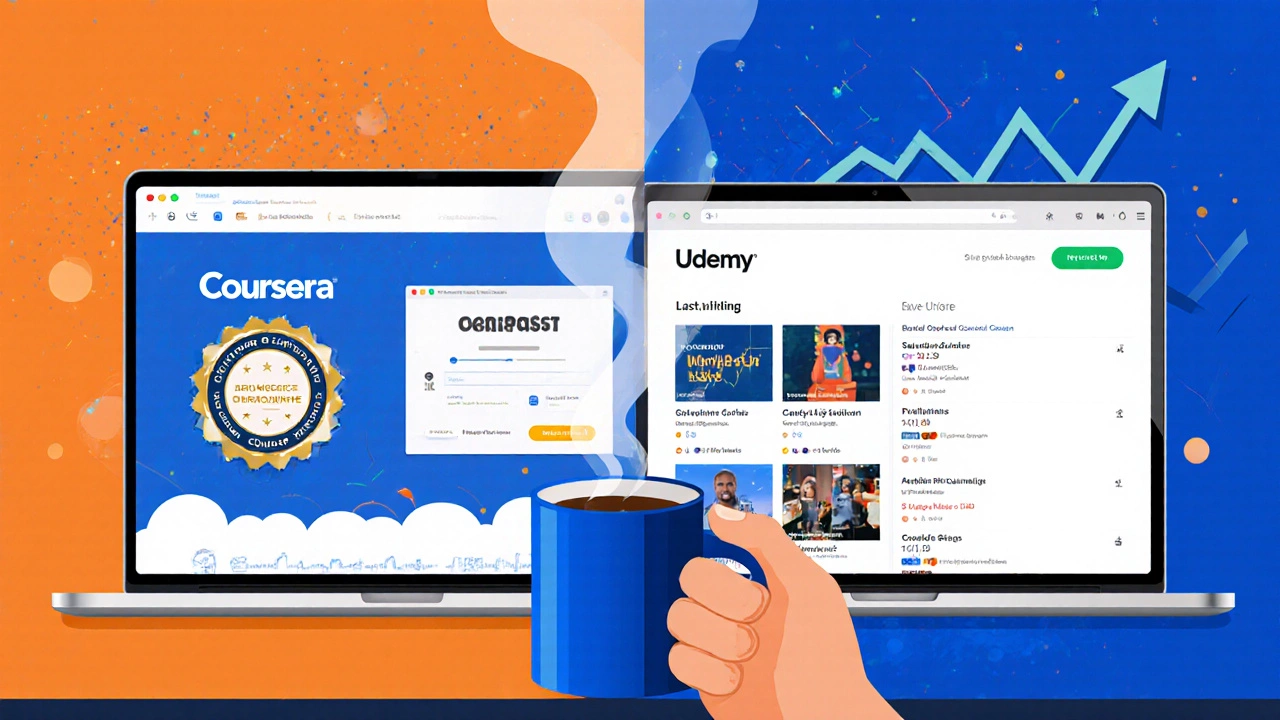Salary Calculator: $75K Without a Degree
Calculate Your Earnings
What's Your Target?
The average income for these fields starts at $75K per year. With consistent work in your chosen field, this is achievable within 12-18 months.
No‑Degree High‑Income Careers are well‑paid jobs you can start after finishing targeted online courses rather than a four‑year degree, and they can push your earnings past make $75,000 without college. You don’t need a fancy diploma, just a clear roadmap, the right skills, and a platform that actually helps you land paid work. Below you’ll find the exact steps that turned a handful of self‑learners into six‑figure earners, plus the tools that keep the learning curve shallow.
1. Pick a career that pays $75K and doesn’t demand a degree
Not every online skill translates into a six‑figure salary. The sweet spot lies where market demand, earning potential, and certification availability intersect. Here are the top five options that consistently hit or exceed the $75K mark.
- Freelance Web Development - Master HTML, CSS, JavaScript, and a back‑end language like Node.js or Python, then sell sites on platforms like Upwork. Top freelancers routinely earn $80-$120K per year.
- Digital Marketing - Specialize in SEO, paid ads, and conversion rate optimization. Agencies hire remote specialists for $70-$100K, and successful consultants break the $150K barrier.
- Data Analysis with Python - Learn pandas, SQL, and data visualization. Companies pay $75K-$110K for analysts who can turn raw data into actionable insight.
- UX/UI Design - Combine visual design tools (Figma, Sketch) with user‑research methods. Mid‑level designers earn $80K on average.
- Amazon FBA Business - Source products, ship to Amazon’s warehouses, and let the platform handle logistics. Successful sellers report $75K-$200K in net profit.
Each of these paths can be launched from a bedroom in Chennai or any city with a reliable internet connection. The key is to pick one that matches your interests, because persistence beats any technical advantage.
2. Choose the right online course platform
Even the best career choice will stall without quality training. Below is a side‑by‑side look at the five platforms that consistently deliver high‑impact certificates and job‑ready projects.
| Platform | Typical Course Price | Certificate Value | Job Placement Support | Average Salary After Completion |
|---|---|---|---|---|
| Coursera | $39-$79 per month | University‑backed | Career Services, LinkedIn integration | $82,000 |
| Udemy | $12-$199 per course | Instructor‑issued | Community forums, occasional employer partnerships | $70,000 |
| edX | $50-$300 per course | University‑issued | Micro‑Masters pathways, employer recognitions | $85,000 |
| LinkedIn Learning | $29.99 per month | LinkedIn badge | Direct recruiter visibility | $78,000 |
| Skillshare | $15-$30 per month | None (focus on portfolio) | Project‑based community showcase | $68,000 |
For most six‑figure goals, Coursera and edX win because their certificates carry university weight, and both platforms provide direct links to recruiters on LinkedIn. If you’re on a tight budget, Udemy’s frequent sales let you buy a full‑stack web development bundle for under $30.
3. Build a concrete learning roadmap
Skipping the planning stage is the fastest way to burn out. Here’s a 12‑month timeline that aligns coursework with real‑world practice.
- Month 1‑2: Foundations - Complete an introductory course on your chosen field (e.g., "Web Development Basics" on Coursera). Finish all quizzes and build a simple personal project.
- Month 3‑4: Skill Deep‑Dive - Enroll in a specialization (e.g., "Full‑Stack Development" on edX). Focus on one language’s ecosystem; add a GitHub repo for each assignment.
- Month 5‑6: Portfolio Creation - Build three showcase projects that solve real problems (e.g., a local restaurant’s website, a SEO audit report, a data‑driven sales dashboard).
- Month 7‑8: Certification - Take the official exam (Google UX Design Certificate, AWS Certified Cloud Practitioner, etc.). Add the badge to LinkedIn and your resume.
- Month 9‑10: Freelance Jump‑Start - Create profiles on Upwork, Fiverr, and Toptal. Pitch to at least five clients per week, offering a discounted first project to build reviews.
- Month 11‑12: Scale Up - Raise rates by 30‑50% after landing three repeat clients. Simultaneously apply to remote full‑time roles; many companies now list “no degree required” in their job ads.
Stick to the schedule, track progress in a spreadsheet, and adjust only when a milestone feels unachievable. Consistency trumps intensity every time.
4. Turn skill acquisition into real income
Learning alone won’t pay the bills; you need a revenue engine. Below are three proven models that convert course completion into a $75K+ salary.
- Freelance Client Work: Charge $40‑$70 per hour for web development or digital marketing. Working 20 billable hours per week already tops $44K; add project‑based premiums and you’re easily past $75K.
- Remote Full‑Time Position: Companies like Automattic, Shopify, and Dell advertise “no degree required” roles for UI designers, data analysts, and cloud support engineers. Base salaries start at $70K, with bonuses and stock options pushing total compensation higher.
- Product‑Based Business: Launch an Amazon FBA product or sell digital templates on Gumroad. Initial investment $1,000-$2,000, and a successful launch can yield $5,000-$10,000 per month.
Many high‑earning professionals blend all three: freelance on the side, work a remote job for stability, and grow a side‑hustle that eventually replaces the 9‑to‑5.

5. Avoid common pitfalls that stall earnings
Even with the perfect plan, missteps can derail progress. Here’s what to watch out for.
- Chasing shiny new courses: Stick to one curriculum until you’ve built a portfolio. Switching every month leaves you with certificates but no depth.
- Under‑pricing services: Low rates attract cheap work, not high‑value clients. Position yourself as a specialist and let price reflect expertise.
- Neglecting networking: A single LinkedIn connection can lead to a six‑figure contract. Spend 30 minutes daily commenting on industry posts and joining relevant groups.
- Skipping practical projects: Theory is useless without a showcase. Every new skill should be demonstrated in a live, shareable project.
Fixing these habits early saves months of wasted effort and accelerates the path to $75K.
6. Quick checklist - your six‑figure roadmap at a glance
- ✅ Choose a high‑paying, no‑degree career.
- ✅ Enroll in a reputable platform (Coursera/edX).
- ✅ Follow the 12‑month learning timeline.
- ✅ Earn a recognized certificate.
- ✅ Build three portfolio projects.
- ✅ Set up freelance profiles and apply for remote jobs.
- ✅ Launch a side‑business for extra income.
- ✅ Network daily on LinkedIn.
Check each box weekly. When the list is full, you’ve built a sustainable $75K‑plus income stream without ever stepping foot in a lecture hall.
Can I really earn $75,000 with only online courses?
Yes. The combination of high‑demand skills, reputable certificates, and focused client acquisition consistently produces salaries and freelance earnings in the $75K‑$120K range. Real‑world examples include former teachers turned SEO consultants and recent graduates who built $80K freelance web development businesses in under a year.
Do I need any prior experience before taking these courses?
No formal background is required. Most platforms start with beginner modules that assume zero knowledge. The key is to commit to the hands‑on projects, which bridge the gap between theory and work‑ready competence.
How long does it take to start earning six figures?
A disciplined learner can reach the $75K milestone in 12‑18 months: six months of intensive study, three months of portfolio building, and the remaining time focused on client acquisition or remote job interviews.
Are certificates from these platforms recognized by employers?
Certificates from Coursera (partnering universities) and edX (MIT, Harvard) are widely accepted. Recruiters often filter candidates by these badges on LinkedIn, and many hiring managers list them as a ‘preferred qualification’ in job descriptions.
